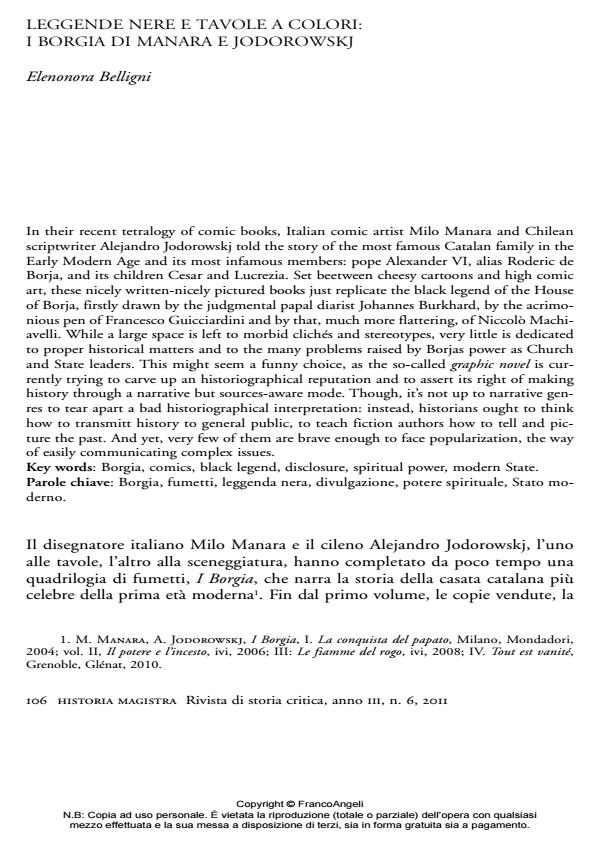Leggende nere e tavole a colori: i Borgia di Manara e Jodorowsky
Titolo Rivista HISTORIA MAGISTRA
Autori/Curatori Eleonora Belligni
Anno di pubblicazione 2011 Fascicolo 2011/6
Lingua Italiano Numero pagine 9 P. 106-114 Dimensione file 117 KB
DOI 10.3280/HM2011-006012
Il DOI è il codice a barre della proprietà intellettuale: per saperne di più
clicca qui
Qui sotto puoi vedere in anteprima la prima pagina di questo articolo.
Se questo articolo ti interessa, lo puoi acquistare (e scaricare in formato pdf) seguendo le facili indicazioni per acquistare il download credit. Acquista Download Credits per scaricare questo Articolo in formato PDF

FrancoAngeli è membro della Publishers International Linking Association, Inc (PILA)associazione indipendente e non profit per facilitare (attraverso i servizi tecnologici implementati da CrossRef.org) l’accesso degli studiosi ai contenuti digitali nelle pubblicazioni professionali e scientifiche
In their recent tetralogy of comic books, Italian comic artist Milo Manara and Chilean scriptwriter Alejandro Jodorowskj told the story of the most famous Catalan family in the Early Modern Age and its most infamous members: pope Alexander VI, alias Roderic de Borja, and its children Cesar and Lucrezia. Set beetween cheesy cartoons and high comic art, these nicely written-nicely pictured books just replicate the black legend of the House of Borja, firstly drawn by the judgmental papal diarist Johannes Burkhard, by the acrimonious pen of Francesco Guicciardini and by that, much more flattering, of Niccolò Machiavelli. While a large space is left to morbid clichés and stereotypes, very little is dedicated to proper historical matters and to the many problems raised by Borjas power as Church and State leaders. This might seem a funny choice, as the so-called graphic novel is currently trying to carve up an historiographical reputation and to assert its right of making history through a narrative but sources-aware mode. Though, it’s not up to narrative genres to tear apart a bad historiographical interpretation: instead, historians ought to think how to transmitt history to general public, to teach fiction authors how to tell and picture the past. And yet, very few of them are brave enough to face popularization, the way of easily communicating complex issues.
Parole chiave:Borgia, fumetti, leggenda nera, divulgazione, potere spirituale, Stato moderno
Eleonora Belligni, Leggende nere e tavole a colori: i Borgia di Manara e Jodorowsky in "HISTORIA MAGISTRA" 6/2011, pp 106-114, DOI: 10.3280/HM2011-006012